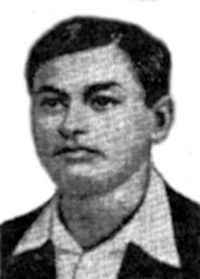Native name বিনয় কৃষ্ণ বসু Name Benoy Basu Ethnicity Bengali | Nationality [Indian] Parents Rebatimohan Basu | |
 | ||
Born 11 September 1908 ( 1908-09-11 ) Died December 13, 1930, Kolkata | ||
Other names Benoy Basu, Benoy Bose | ||
Binoy Krishna Basu (Bengali: বিনয় কৃষ্ণ বসু Binôe Boshu) or Binoy Basu or Binoy Bose (1908–1930) was a Bengali freedom fighter (against British rule) who is noted for launching an attack on the Secretariat Building - the Writers' Building in the Dalhousie square in Kolkata.
Contents
Early life
Basu was born on 11 September 1908, in the village Rohitbhog in the Munshiganj District, now in Bangladesh. His father, Rebatimohan Basu was an engineer.
After passing the Matriculation Examination in Dhaka, Benoy enrolled into the Mitford Medical School (now Sir Salimullah Medical College).Under the influence of Hemchandra Ghosh, a revolutionary of Dhaka, Benoy joined the 'Mukti Sangha', a secret society closely connected with the Jugantar Party. He could not complete medical studies due to his association with revolutionary activities.
Revolutionary activities
Basu and his peer revolutionaries joined Bengal Volunteers - a group organised by Subhas Chandra Bose in 1928, at the occasion of Calcutta session of the Indian National Congress. Soon Benoy started a local unit of the organisation in Dhaka, named Bengal Volunteers in Dacca. Later, the Bengal Volunteers became a more active revolutionary association and prepared a plan of "Operation Freedom" against the police repression in Bengal, especially against the inhuman conduct with the political prisoners in different jails.
In August 1930, the revolutionary group planned to kill Lowman, the Inspector General of Police who was due to present in the Medical School Hospital to see an ailing senior police official undergoing treatment. On 29 August 1930, Benoy casually clad in a traditional Bengali attire, breached the security and fired at close range. Lowman died instantly and Hodson, the Superintendent of police, was grievously injured.
His identity was never a secret. A copy of his photo was taken out of college magazine and pasted all over. A reward of Rs. 10,000/- was announced. But Benoy was far from helping someone receiving it. He was ultimately caught only to die at the Medical College Hospital in Kolkata, after the Battle of the Verandah. In August, there are torrential rains in East Bengal. One such morning two Muslim villagers, with tatters covering their bare bodies were seen wading through knee-deep water. The nearest railway station, Dolaiganj, was their destination. They entered the platform which was swarming with policemen. Benoy's photo was pasted all around. The train from Dhaka to Narayanganj arrived. Every compartment was searched thoroughly. Benoy and his companion got into a third class compartment which was already over-crowded. When the train reached Narayanganj, the police searched not only the train but had instructions to search the boats also. A river had to be crossed before one could reach Kolkata. Benoy came to know of it through his own sources. When the train slowed near a flag station, he began to walk towards the Ghat for a boat. They had to hire one to cross the turbulent Meghna. They changed their address, from Muslim beggars in tatters to one of a Zamindar with a servant. For a while they had to travel by a steamer. The whole episode was like a scene from a film. The name of the companion was Supati Roy. On reaching the city, they avoided Sealdah, the terminus, and got down at Dum Dum, a small way-side station. The journey from there to the slum area of No. 7, Waliullah lane in Central Kolkata, was somewhat uneventful. But a long stay for unknown persons might arouse suspicion. Benoy shifted to a colliery at Katras Garh and from there to a peaceful place in North Kolkata. But he always had the premonition that the police would soon find him out. His fear proved correct when the police chief, Sir Charles Tegart, arrived there with a posse of policemen. By this point, however, Benoy had fled.
The last battle
The next target was Col NS Simpson, the Inspector General of Prisons, who was infamous for the brutal oppression on the prisoners in the jails. The revolutionaries decided not only to murder him, but also to strike terror in the British official circles by launching an attack on the Secretariat Building – the Writers' Building in the Dalhousie square in Kolkata.
On 8 December 1930, Benoy along with Dinesh Gupta and Badal Gupta, dressed in European costume, entered the Writers' Building and shot dead Simpson.
British police started firing. What ensued was a brief gunfight between the three young revolutionaries and the police. Some other officers, such as Twynam, Prentice and Nelson, suffered injuries during the shooting.
Soon police overpowered them. However, the three did not wish to be arrested. Badal took potassium cyanide, while Benoy and Dinesh shot themselves with their own revolvers. Benoy was taken to the hospital where he died on 13 December 1930.
Significance
The martyrdom and self-sacrifice of Benoy, Badal and Dinesh inspired further revolutionary activities in Bengal in particular and India in general.
After Indian independence, the Dalhousie square was named B.B.D. Bagh - after the Benoy-Badal-Dinesh trio. In memory of their writers' attack a plate was engraved in the wall of Writers' Building, first floor.
